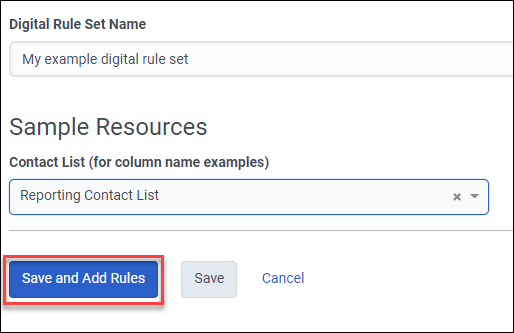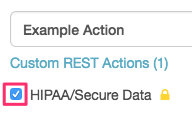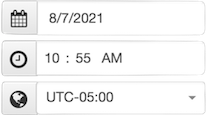Use a digital rule to evaluate information from a data action
You can use a data action as a digital rule condition. When you use a data action as a rule condition, a pre-contact rule can evaluate response data from the Genesys Cloud Public API, Salesforce, Zendesk, or REST API endpoints. This procedure explains how to set up a rule that runs a data action, and then evaluates the information it returns.
- For all evaluation rules, see the following instructions that follow in Setup and configure an evaluation rule.
- Perform one of the following tasks:
- To use a data action as a condition, see the following instructions in Use a data action as a condition.
- To use any other condition, follow the instructions in Add a call rule.
- To use an action, follow the instructions in Configure rule actions.
- Click Admin.
- Under Outbound, click Rule Management.
- On the Digital Rule Sets tab, click Create New. The Create Digital Rule Set page opens.
- In the Digital Rule Set Name box, type a name for this rule set.
- If your data action needs contact data, select a contact list from the Contact List box so that you can select its columns later.

- Click Save and Add Rules. The Add Digital Rule page opens. Note: If this set already contains rules, click Add New Rule instead.
- In the Digital Rule Name box, type a name.
- In the Category box, select Pre-Contact.
- Configure the conditions for this rule, and then save the rule.
- Under Conditions, click inside the Type box, and then select Data Action.
- To display a list of available data actions, click the Data Action box, and then select a data action from the list.
Next, you can enter the data action conditions for the selected data action.
Notes:- If no existing data actions are relevant, create a new data action. See Create a custom action for integrations. To create a data action, you must know the data action’s input and output contracts, endpoint, and other parameters. Contracts define the format of data passed to the data action or returned by it. The endpoint is the address of the API call. For more information, see About integrations, About the Genesys Cloud data actions integration, and About custom actions for integrations.
- If you configure data actions for the campaign, this process can impact (slow down) the message sending speed. The efficiency of data actions is important. Data actions that make an API call or conduct a database lookup that takes a long time to complete can slow down message sending speed.
- If the system displays ‘The input contract on the data action must be of type object”, then the selected data action is not compatible with outbound. A compatible contract resembles this schema:

- To view the input contract for a data action, select Actions from the Admin menu. To open a data action, select its name. Then, select the Input Contract tab. The data in the schema must define the values as belonging to an object. See Create a custom action for integrations.
- To correlate campaign data with input values of the data action, use the controls below Map of Outbound Values to Data Action Inputs. This mapping tells the rule what information to pass to the data action before the data action runs.
- In the Outbound Value list, select an item of information to pass to the data action. Your selection of outbound values is based on the contact list selected.
- In the Data Action Input list, select which input value of the data action receives the outbound value. For example, you can map a phone number from the campaign to a data action’s Cell value.
 Tip: If the system displays a validation warning, then the data action is not configured as a HIPAA/Secure Data compliant data action. Reconfigure the data action and make it secure before you use the data action in outbound. To reconfigure the action, click Admin. Under Integrations, click Actions. Click the data action name and then enable the HIPAA/Secure Data box.
Tip: If the system displays a validation warning, then the data action is not configured as a HIPAA/Secure Data compliant data action. Reconfigure the data action and make it secure before you use the data action in outbound. To reconfigure the action, click Admin. Under Integrations, click Actions. Click the data action name and then enable the HIPAA/Secure Data box. The inputs to a data action are based on its contracts. Contracts are JSON schema statements (specified when someone creates a data action) that define what data passes to a function or what the function returns.
The inputs to a data action are based on its contracts. Contracts are JSON schema statements (specified when someone creates a data action) that define what data passes to a function or what the function returns. - To map more outbound values to data action inputs, click the plus below the last configured row. Repeat this step until you map all inputs that the data action needs.
When the rule uses this association between outbound values and data action inputs, it passes to the data action any data it needs. For example, a data action can use a column from the contact list to retrieve information from a CRM.
- Control whether the rule action performs when the condition is met or not met.
In some situations, you may want to invert the condition so that the system performs its data action when the opposite of the condition is true. This inversion is accomplished by setting the Invert Condition switch to Yes. An inverted condition performs rule actions when the condition is not met.
Perform one of the following steps:-
To perform a rule action when the condition is met, set Invert Condition = No. This setting is the default.
-
To perform a rule action when the condition is not met, set Invert Condition = Yes.
-
-
After you define the defined inputs to the data action, configure your rule to evaluate the information returned by the data action. Use the Output Evaluations section to set up expressions that evaluate any return value in the data action’s Output contract.
-
Select a return value from the Data Action Output box.
-
Select an operator from the Comparator box.
Currency evaluations
A data action condition can evaluate currency values, but only if the output result has two or fewer decimal places.
If a result has more than two decimal places, the rules cannot evaluate it.
Time evaluations
String, Boolean, and numeric comparators are intuitive. You can compare date strings to relative times or to specific times. Both types of time comparators provide “Is Earlier Than” and “Is Later Than” comparators. The difference is whether the value compares with an exact date and time, or is relative to the current time, in the past or the future. A specific time value is set by configuring:

But a relative time value is set by configuring a time offset:

-
In the Value box, type a value. This value compares with the value returned by the data action, and uses the selected comparator. For example, you can check to see if a postal code begins with the number 5:
 Note: String comparisons are case-sensitive.
Note: String comparisons are case-sensitive.
-
- (Optional) To invert the comparison operator, enable the invert comparator box. For example, if you invert the Begins With comparator, the evaluation resolves true if the value does not begin with the specified value.
- (Optional) Set When there is no value for the data action output field, this evaluation resolves to True. If the output contains no data, you can decide whether the expression returns True or False. False is the default.
- (Optional) To evaluate another output value, click Add. Repeat steps 1 through 7 to configure the new evaluation condition. Note: Conditions join with the AND operator, so a call must meet all rule conditions for the overall rule to evaluate True.
- (Optional) If the data action returns no data, to control whether the condition evaluates True or False, click the Data Not Found Resolution switch. False is the default, which means that the condition returns False when the data action returns no data. Note: If the data action returns no data, the Data Not Found Resolution overrides the Invert Condition setting.
- To use an action, follow the instructions in Configure rule actions.
OUTBOUND-RULE-ERROR-SKIPPED. An ERROR level event log is also submitted with the code DATA_ACTION_EXECUTION_FAILED.
Limitations on data types in contracts
When administrators create a custom action for integrations, they define input and output contracts. Some limitations on the data actions that you use with outbound rules include these parameters:
- For both input and output contracts, the top-level type must be an object. An input contract cannot pass an array to a remote endpoint. An outbound contract cannot consume an array of response data unless the data action’s output contract uses a translation map to convert the array to an object.
- Output contracts can allow complex objects or arrays, but outbound messaging does not permit use of those data types in a rule condition. The rule condition can only operate on Boolean, integer, number, and string data types.
- If the endpoint returns a non-JSON response, you must provide a middleware service that transforms the response to JSON. The response to a data action must be a valid JSON. Otherwise, the data action fails.
- Never try to flatten fields in a data action’s output schema. See Guidelines for actions used with outbound dialing rules.
- The maximum number of data action rule conditions that you can have on a single campaign is two.
Limitations of data actions as conditions
When you use data actions as conditions, be aware that there are several limits that affect the speed of sending messages. Data actions that are configured for the campaign can impact (slow down) the message sending speed. The data action service limits how many concurrent data actions can run, in addition to how many can run over a course of a minute and hour.
When outbound messaging operations detect a data action in use on the interaction to be messaged, the system performs a check to see how many concurrent data actions are occurring and slows those respective operations to make sure not to meet the limits on the data action side. Contacts do not message as quickly as those without data actions.
When using data actions as conditions in an evaluation rule, keep in mind this limitation:
- The maximum number of data actions used as conditions is two per rule, rule set, and running campaign.
Note: If you try to add more data actions to a rule, rule set, or campaign than are allowed, the save fails. You see a message that an error has occurred.

